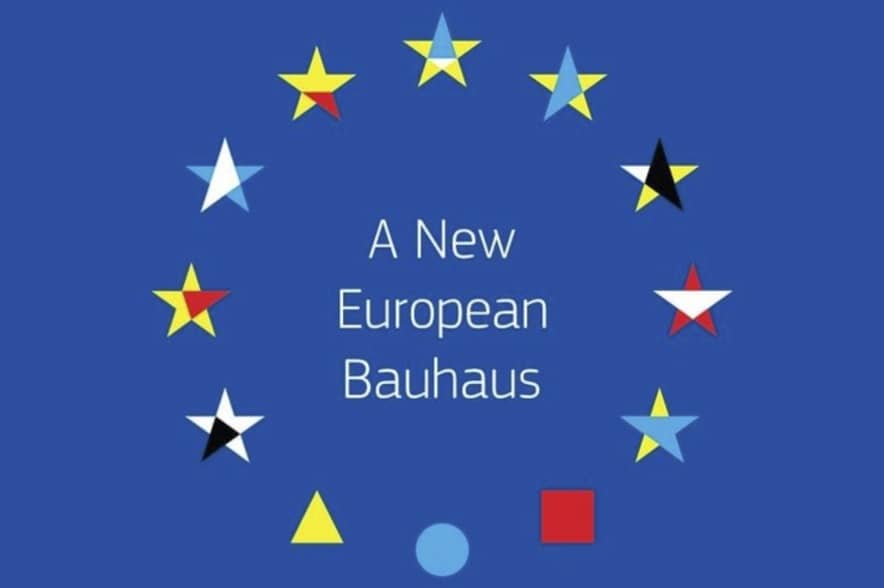
www.buildingsandcities.org/insights/commentaries/radical-bauhaus.html
A New Radical Bauhaus?

What would a radical agenda be for the New European Bauhaus?
Matti Kuittinen (Aalto University) considers the multiple challenges facing society: the climate emergency, loss of biodiversity and overconsumption of material resources. He argues the New European Bauhaus has the potential to adopt a radical agenda, similar to its original namesake, as part of a transformational process. A personal vision is presented of what that radical agenda needs to be in order to tackle these critical issues and create positive cultural change.
The European Commission's cultural masterstroke - the re-establishment of the legendary Bauhaus design school (von der Leyen, 2020) - has raised interest and expectations especially among those who work for the sustainability of the built environment. Recently, I have been involved in organising several co-design events to discuss the role of the New European Bauhaus with thousands of designers, policy-makers, scientists and construction professionals from the Nordic countries and Europe. During these inspiring interactions, there have been repeated calls for a similar sort of radicalism that was distinctive of the original Bauhaus. This has led me to ask: how radical should the agenda of the New European Bauhaus be?
The original Bauhaus was radical indeed. As a response to the realities of post-WW1 Europe, it gave birth to objects and design so different from conventions of the time, that they hardly left anyone indifferent.
Today, we live in the midst of a climate emergency, the sixth mass extinction of wildlife, and our future is darkened by shocking projections of sea-level rise and a tide of climate refugees. Some have already lost joy in life, as ecosystems are collapsing around us - because of us.
The built environment has a long lifespan. Our grandchildren will use buildings and cities that we plan today. The New European Bauhaus agenda includes intergenerational solidarity for a reason: as reported from UNEP´s Youth Environment Assembly in 2021, young generations are showing increasing rates of mental discomfort due to environmental factors (IISD, 2021). Alarmingly, the majority of youth in several countries believe that politicians and adults have betrayed them and ignored their concerns (Hickman et al., 2021). This can only be described as heart breaking.
The world around us begs for fundamental changes in how we act, which also means that architecture needs redefinition. How can we change course? Below, I suggest four approaches for constructively radicalising the core values (sustainability, aesthetics, inclusion) of the New European Bauhaus.
1. Redefining "less is more"
One of the famous quotes that can be attributed to the original Bauhaus movement is Ludwig Mies van der Rohe's "less is more". It can be understood as a call for minimalism and rationalism in building design -resulting in an architectural aesthetic. However, aesthetic rigour cannot solve the ongoing climate and resource crisis. Furthermore, the aesthetics that resulted in many works of the modernism - as pointed out by Moe (2020) in his analytical critique of Mies' iconic Seagram building in New York - has proved to be mostly problematic for both the environment and the society.
Therefore, the iconic quote could lend itself for a new interpretation: should we simply build less, for preserving more resources and more wellbeing for future generations?
Globally speaking, half of our raw materials are used for construction each year (ECORYS & Copenhagen Resource Institute, 2014). The demand for materials may increase further due to a growing global population and the need to adapt buildings, cities and infrastructures to climate change.
Increased demand for construction materials has critical negative impacts on the carrying capacity of our planet. The current production methods for cement, steel, aluminium and plastics alone may cause almost twice the amount of GHG emissions by 2050 than limiting global warming to 1.5 degrees Celsius could allow (Material Economics, 2018).
Research is highlighting the importance of decoupling the material-intensity of construction in the same way we need to break our addiction to energy (see, for example, the Buildings & Cities special issue on Carbon Metrics). Even though building energy efficiency has started to improve, we are still struggling with energy poverty in many parts of our world. The shift to renewables is - thanks to path-dependent infrastructures and active counter-lobbying - painstakingly slow.
Therefore, we need business models that decouple the value of the built environment from resource consumption. Understanding the negative social and environmental consequences is just the start of it. But we also need a cultural change, as others like Klein (2014), von Weizsäcker & Wijkman (2018) have long pointed out. Signs of such cultural change can be identified in the growing movement of design education. For example, Stevenson & Kwok (2020) highlight the importance of mainstreaming zero carbon in education and training.
Less construction today leaves more resources for tomorrow. Less built-up area spares more habitat for non-humans. Doing more with less should reveal the pivotal role of design. However, advancing in the fronts of post-growth and especially de-growth may lead into politically controversial dilemmas - as was the case with the original Bauhaus, but for different reasons.
Nevertheless, these redefinitions of the classic Bauhaus phrase open possibilities for a better future, in which good life and wellbeing are not linked to consumption and resource use.
2. Questioning human-centered construction culture
Until now, animal rights and "human chauvinism" have been actively discussed in relation to diets, consumption, fashion and life styles. Perhaps architecture and construction should "go vegan" next.
Estimates from the UN suggest that 90% of biodiversity loss is associated to extracting raw materials (UNEP, 2019). The fact that half of the annually extracted raw materials go to construction should spark a radical intervention. When rural landscapes are converted into settlements, we not only destroy settlements of other species, but also cut those vital green corridors, through which many animal and plant species are trying to flee the changing climate.
Reconnecting with nature - one the thematic axes of the New European Bauhaus - should therefore go considerably further than merely revitalising human contact with green spaces. We should dare to ask uneasy questions, even considering those that arise from deep ecology and especially from biocentrism: What is our justification for extracting construction materials for our business and pleasure, if it risks the existence of other species? What is our right to claim land from others for building yet another mall in service of consumerism? Or should cities offer habitats for others than humans?
These questions are philosophical, difficult and radical - exactly the sort of fuel that could be poured into the think tank of the New European Bauhaus.
3. Admitting artifical intelligence (AI) to the ranks of designers
"What will happen to society, politics and daily life when non-conscious but highly intelligent algorithms know us better than we know ourselves?" asks Harari (2015). To continue his profound question: what would our buildings and built environments look like, if their design was controlled by algorithms?
The Bauhaus of the 1920s shocked conservative artists and designers by embracing industrial production. Factories and machines were considered to be an insult to the skills of carpenters, artisans and artists. Following this legacy, the New European Bauhaus could try to identify the next big leaps in the design, construction, management and recycling of our built environments. Building information models or augmented reality in construction work are necessary, but not that radical. An engagement with AI could be.
The capacity and potential of AI are beyond any human skills in many fields of design. An intelligent, digital twin of a building could make perfectly timed and data-driven decisions about energy use or ordering maintenance services; it could even offer vacant spaces to those in need. AI could run countless simulations for defining an optimal solution from technical, economic, social and cultural viewpoints. AI could collaborate with creative designers in generating environments that no human has dreamed before. And by harvesting big data, AI could help even humans in finding a balance with the other forms of life on this planet.
AI should be programmed to focus on the features of the built environment we value. Therefore, the New European Bauhaus should welcome AI and explore its potential applications.
4. Being empathic
An empathic approach can help us to change. It is not easy to break the addiction to materials and energy. There are conflicting interests, concerns of financial loss, even existential questions that can manifest themselves in the form of denialism.
Several studies (e.g. works by Panu Pihkala, Robert Chianese or Sarah Jaquette Ray) have suggested that art and rituals can help to deal with difficult feelings of environmental anxiety. Visualising good outcomes as well as seeking beauty can be channels for personal and societal self-care in the midst of overwhelming anxiety (Ray, 2020).
Acknowledging this latent potential is a strong, timely justification for the New European Bauhaus. This was also on the agenda of the original Bauhaus. But interestingly, so were also rituals. Breathing exercises, meditation, gymnastics and performances were used for internalising design ideals. Killip (2020) explains that education must include not only ' 'know why' (knowledge) and know how' (skill) but also 'know how to be' (savoir etre or character). Now, there is a much more to be internalised in societies' practices, expectations and cultural meanings. Fresh approaches for that are needed in education.
Thus, the good old Bauhaus-approach that combines art and architecture with science and technology could be the right prescription to rehabilitate us from the vanities of the linear economy. This time, however, the New European Bauhaus faces the task of having to generate a set of values, ethos and curricula in a very short timeframe, while balancing with its social and political acceptability.
A new, radical Bauhaus?
There is no question that the time to act is now. We need an unprejudiced agenda for building a better future. The New European Bauhaus is a perfectly timed opportunity for redesigning the course of the Anthropocene. Let´s make it radical!
References
ECORYS & Copenhagen Resource Institute. (2014). Resource efficiency in the building sector. Final report for DG Environment. https://ec.europa.eu/environment/eussd/pdf/Resource%20efficiency%20in%20the%20building%20sector.pdf
Harari , Y.N. (2015). Homo Deus: A Brief History of Tomorrow. London: Vintage.
Hickman, C., Marks, E., Pihkala, P., Clayton, S., Lewandowski, E.R., Mayall, E.E., Wray, B., Mellor, C., van Susteren, E. (2021). Young people's voices on climate anxiety, government betrayal and moral injury: a global phenomenon. Lancet (Preprint). https://papers.ssrn.com/sol3/papers.cfm?abstract_id=3918955
IISD (2021). Climate anxiety highlighted at youth environment assembly. International Institute for Sustainable Development. https://sdg.iisd.org/news/climate-anxiety-highlighted-at-youth-environment-assembly/
Killip, G. (2020). A reform agenda for UK construction education and practice. Buildings and Cities, 1(1), pp. 525-537. DOI: https://doi.org/10.5334/bc.43
Klein, N. (2014). This Changes Everything: Capitalism vs. the Climate. New York: Simon & Schuster.
Material Economics (2018). Circular economy: a powerful tool for climate mitigation. https://materialeconomics.com/publications/the-circular-economy
Moe, K. (2020). Unless: The Seagram Building Construction Ecology. New York: Actar.
Ray, S.J. (2020). A Field Fuide to Climate Anxiety: How to Keep Your Cool on a Warming Planet. Oakland: University of California Press.
Stevenson, F. & Kwok, A. (2020). Mainstreaming zero carbon: lessons for built-environment education and training. Buildings and Cities, 1(1), 687-696. DOI: http://doi.org/10.5334/bc.84
UNEP (2019). Global resources outlook. United Nations Environmental Programme. https://wesr.unep.org/irp/index/1
von der Leyen, U. (2020). A New European Bauhaus. European Commission. https://ec.europa.eu/commission/presscorner/detail/en/AC_20_1916
von Weizsäcker, E. & Wijkman, A. (2018). Come On! Capitalism, Short-termism, Population and the Destruction of the Planet. A Report to the Club of Rome. New York: Springer Science.
Latest Peer-Reviewed Journal Content
Designing for pro-environmental behaviour change: the aspiration–reality gap
J Simpson & J Uttley
Lifetimes of demolished buildings in US and European cities
J Berglund-Brown, I Dobie, J Hewitt, C De Wolf & J Ochsendorf
Expanding the framework of urban living labs using grassroots methods
T Ahmed, I Delsante & L Migliavacca
Youth engagement in urban living labs: tools, methods and pedagogies
N Charalambous, C Panayi, C Mady, T Augustinčić & D Berc
Co-creating urban transformation: a stakeholder analysis for Germany’s heat transition
P Heger, C Bieber, M Hendawy & A Shooshtari
Placemaking living lab: creating resilient social and spatial infrastructures
M Dodd, N Madabhushi & R Lees
Church pipe organs: historical tuning records as indoor environmental evidence
B Bingley, A Knight & Y Xing
A framework for 1.5°C-aligned GHG budgets in architecture
G Betti, I Spaar, D Bachmann, A Jerosch-Herold, E Kühner, R Yang, K Avhad & S Sinning
Net zero retrofit of the building stock [editorial]
D Godoy-Shimizu & P Steadman
Co-learning in living labs: nurturing civic agency and resilience
A Belfield
The importance of multi-roles and code-switching in living labs
H Noller & A Tarik
Researchers’ shifting roles in living labs for knowledge co-production
C-C Dobre & G Faldi
Increasing civic resilience in urban living labs: city authorities’ roles
E Alatalo, M Laine & M Kyrönviita
Co-curation as civic practice in community engagement
Z Li, M Sunikka-Blank, R Purohit & F Samuel
Preserving buildings: emission reductions from circular economy strategies in Austria
N Alaux, V Kulmer, J Vogel & A Passer
Urban living labs: relationality between institutions and local circularity
P Palo, M Adelfio, J Lundin & E Brandão
Living labs: epistemic modelling, temporariness and land value
J Clossick, T Khonsari & U Steven
Co-creating interventions to prevent mosquito-borne disease transmission in hospitals
O Sloan Wood, E Lupenza, D M Agnello, J B Knudsen, M Msellem, K L Schiøler & F Saleh
Circularity at the neighbourhood scale: co-creative living lab lessons
J Honsa, A Versele, T Van de Kerckhove & C Piccardo
Positive energy districts and energy communities: how living labs create value
E Malakhatka, O Shafqat, A Sandoff & L Thuvander
Built environment governance and professionalism: the end of laissez-faire (again)
S Foxell
Co-creating justice in housing energy transitions through energy living labs
D Ricci, C Leiwakabessy, S van Wieringen, P de Koning & T Konstantinou
HVAC characterisation of existing Canadian buildings for decarbonisation retrofit identification
J Adebisi & J J McArthur
Simulation and the building performance gap [editorial]
M Donn
Developing criteria for effective building-sector commitments in nationally determined contributions
P Graham, K McFarlane & M Taheri
Join Our Community

The most important part of any journal is our people – readers, authors, reviewers, editorial board members and editors. You are cordially invited to join our community by joining our mailing list. We send out occasional emails about the journal – calls for papers, special issues, events and more.
We will not share your email with third parties. Read more



Latest Commentaries
COP30 Report
Matti Kuittinen (Aalto University) reflects on his experience of attending the 2025 UN Conference of the Parties in Belém, Brazil. The roadmaps and commitments failed to deliver the objectives of the 2025 Paris Agreement. However, 2 countries - Japan and Senegal - announced they are creating roadmaps to decarbonise their buildings. An international group of government ministers put housing on the agenda - specifying the need for reduced carbon and energy use along with affordability, quality and climate resilience.
Building-Related Research: New Context, New Challenges
Raymond J. Cole (University of British Columbia) reflects on the key challenges raised in the 34 commissioned essays for Buildings & Cities 5th anniversary. Not only are key research issues identified, but the consequences of changing contexts for conducting research and tailoring its influence on society are highlighted as key areas of action.